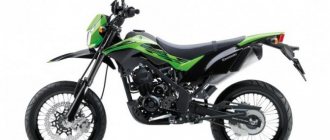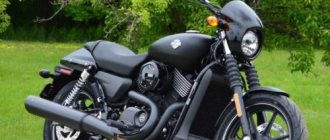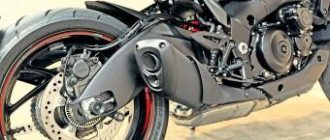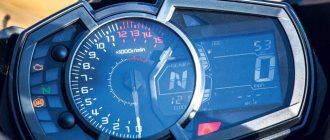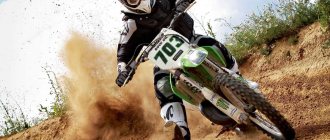| Kawasaki KLX300R (KLX300-A/B) 1996-2007 | Kawasaki KLX300R (KLX300-C) 2020+ |
Enduro model Kawasaki KLX300
appeared in 1996 on the domestic Japanese market, and a year later became available in Europe and North America.
The full name of the model is Kawasaki KLX300R
.
Factory code - KLX300-A
.
In 1997, a modification began to be offered on the European market under the factory code KLX300-B
, which was positioned as a “road” version with a full dashboard (the basic version only had a trip meter), mirrors and turn signals. It existed until 1999 on the market of some European countries.
The Kawasaki KLX 300 was based on a 1-cylinder 4-stroke liquid-cooled engine with a volume of 292 cm³, with 4 valves and two camshafts (DOHC), producing up to 33 hp of power and 28 Nm of torque. The motorcycle frame is a steel tubular structure. Suspension is adjustable: front inverted fork with a diameter of 43 mm (compression adjustable), rear - progressive Uni-Trak swingarm with fully adjustable shock absorber.
Since 2004, the model leaves the European market and is offered primarily in the American market. 2007 was the last year of production.
Since 2022, Kawasaki has offered a new generation of the KLX300 model, which received the factory code KLX300-C
. The new model received an updated appearance, an injection power system, an electric starter (the previous generation was equipped only with a kick), revised suspension settings and an updated braking system. Currently, this version is only available in the North American and Australian markets.
Main competitors of Kawasaki KLX300:
- Honda CRF300L
Brief history of the model
- 1996 - start of production and sales. The model is only available on the Japanese market.
Model
: Kawasaki KLX300 (KLX300R) (Japan).
Factory designation
: KLX300-A1.
- 1997 - The model leaves the Japanese market and becomes available in Europe and North America. In Europe, a road version (KLX300-B) is additionally available.
Model
: Kawasaki KLX300 (KLX300R) (Europe, North America).
Factory designation
: KLX300-A2; KLX300-B1.
- 1998 - no significant changes.
Model
: Kawasaki KLX300 (KLX300R) (Europe, North America).
Factory designation
: KLX300-A3; KLX300-B2.
- 1999 - the last year of production of the version for public roads (KLX300-B).
Model
: Kawasaki KLX300 (KLX300R) (Europe, North America).
Factory designation
: KLX300-A4; KLX300-B3.
- 2000 - no significant changes.
Model
: Kawasaki KLX300 (KLX300R) (Europe, North America).
Factory designation
: KLX300-A5.
- 2001 - no significant changes.
Model
: Kawasaki KLX300 (KLX300R) (Europe, North America).
Factory designation
: KLX300-A6.
- 2002 - no significant changes.
Model
: Kawasaki KLX300 (KLX300R) (Europe, North America).
Factory designation
: KLX300-A7.
- 2003 is the last year of production of European versions.
Model
: Kawasaki KLX300 (KLX300R) (Europe, North America).
Factory designation
: KLX300-A8.
- 2004 - no significant changes.
Model
: Kawasaki KLX300 (KLX300R) (North America).
Factory designation
: KLX300-A9.
- 2005 - no significant changes.
Model
: Kawasaki KLX300 (KLX300R) (North America).
Factory designation
: KLX300-A10.
- 2006 - no significant changes.
Model
: Kawasaki KLX300 (KLX300R) (North America).
Factory designation
: KLX300-A6F.
- 2007 is the last year of production of the generation.
Model
: Kawasaki KLX300 (KLX300R) (North America).
Factory designation
: KLX300-A7F.
- 2020 - new generation of the model.
Model
: Kawasaki KLX300 (KLX300R) (North America, Australia).
Factory designation
: KLX300-CLF.
- 2021 - no significant changes.
Model
: Kawasaki KLX300R (North America).
Factory designation
: KLX300-CMFNL, KLX300-CMFNN.
- 2022 - no significant changes.
Model
: Kawasaki KLX300R (North America).
Factory designation
: KLX300-CNFNL, KLX300-CNFNN.
Specifications
Technical specifications of Kawasaki KLX300 (KLX300R):
| Model | Kawasaki KLX300 (KLX300R) |
| Motorcycle type | enduro |
| Year of issue | 1996-2007, 2020+ |
| Frame | steel half-duplex |
| engine's type | 1-cylinder, 4-stroke |
| Working volume | 292 cm³ |
| Bore/Stroke | 78.0 x 61.2 mm |
| Compression ratio | 11.0:1 11.1:1 – KLX300-C |
| Cooling | liquid |
| Number of valves per cylinder | DOHC chain drive, 4 valves |
| Fuel supply system | Carburetor, 1x Keihin CVK34 Injector (DFI), 1x 34 mm – KLX300-C |
| Ignition type | CDI fully transistorized – KLX300-C |
| Maximum power | 33.0 hp (24.3 kW) at 8500 rpm – KLX300-A 26.0 hp (19.1 kW) at 8500 rpm - KLX300-A (USA) 23.4 hp (17.2 kW) at 8100 rpm[1] - KLX300-C dyno data |
| Maximum torque | 28.4 Nm (2.9 kg*m) at 7500 rpm – KLX300-A 27.5 Nm (2.8 kg*m) at 6500 rpm – KLX300-A (USA) 20.9 Nm (2.2 kg*m) / 8000 rpm[2] - KLX300-C data from the dyno |
| Clutch | Multi-disc in oil bath, cable drive |
| Transmission | 6-speed |
| type of drive | chain |
| Front tire size | 80/100-21 (51M) |
| Rear tire size | 100/100-18 (59M) |
| Front brakes | 1 disc, 2-piston caliper 1 disc, 270 mm, 2-piston caliper – KLX300-C |
| Rear brakes | 1 disc, 1-piston caliper 1 disc, 240 mm, 1-piston caliper – KLX300-C |
| Front suspension | 43mm inverted fork (compression adjustable), 290mm travel 43mm inverted fork (compression adjustable), 285mm travel – KLX300-A (North America), KLX300-C |
| Rear suspension | Uni-Trak swingarm with monoshock (fully adjustable), 280 mm travel Uni-Trak swingarm with monoshock (fully adjustable), 285 mm travel – KLX300-C |
| Motorcycle length | 2115 mm 2120 mm – KLX300-C |
| Motorcycle width | 910 mm 825 mm – KLX300-C |
| Motorcycle height | 1220 mm 1250 mm – KLX300-C |
| Wheelbase | 1435 mm |
| Seat height | 925 mm |
| Minimum ground clearance (clearance) | 320 mm 305 mm – KLX300-C |
| Acceleration 0-100 km/h (0-60 mph) | |
| Maximum speed | |
| Gas tank capacity | 9.8 L 7.9 L – KLX300-C |
| Motorcycle weight (curb) | 114 kg 128 kg – KLX300-C |
Kawasaki: end of year premieres
The absence of the usual global autumn motorcycle exhibitions has already affected our way of life. However, it seems that motorcycle manufacturers are still operating on a run-in program, preparing a “pack” of new motorcycles for the canceled EICMA and Intermot. Kawasaki was no exception, having shown before the beginning of the last month of the year the updated Ninja ZX-10R, a new supermotard, a Z H2 streetfighter with improved suspension, and also demonstrated at the stand a working prototype of a completely new hybrid motorcycle.
Kawasaki KLX300 and KLX300 SM
As you know, a supermotard is an enduro or cross-country motorcycle with “small” wheels shod in road tires. Nowadays, factory-ready supermotos are not uncommon; many manufacturers offer customers motorcycles in this form factor. Kawasaki also released the KLX250SF supermotard in 2009 and 2010.
And now a decade later, the Japanese manufacturer has decided to revive the supermoto sector, preparing for the 2021 season not only the KLX300 enduro, but also the KLX300 SM supermotard.
Both bikes have a tubular steel space frame, 43mm inverted forks and a gas-assist monoshock with Uni-Trak progressive linkage.
The KLX300 and KLX300 SM have a 292 cc short-stroke (78.0 x 61.2 mm) single-barrel engine with a compression ratio of 11.1:1 and a 6-speed gearbox.
The enduro has 18- and 21-inch wheels; the motard has 17-inch wheels, shod with IRC Street Winner road tires. The saddle height of the SM version has also logically decreased, from 895 to 860 mm.
Both motorcycles have the same 240mm rear brake discs with a single-piston caliper, with a 250mm petal or 300mm semi-floating disc brake at the front, depending on the version.
Prices are already known: $5,599 for the Kawasaki KLX300 in Lime Green, $5,799 for the same in Fragment Camo Gray. The KLX300 SM will cost $5,999 and will be available next year in Lime Green/Ebony and Oriental Blue/Ebony color schemes.
Kawasaki Z H2 SE : Skyhook suspension
The Kawasaki H2R supercharged streetfighter was ready by early 2022. By 2021, the Kawasaki Z H2 will receive a new Showa electronic suspension and improved brakes, as well as an SE postfix in the name.
The 2022 Kawasaki Z H2 SE will feature the Kawasaki Electronic Control Suspension (KECS) system, which uses sensors located on the fork and shock absorber, as well as data from the inertial accelerometer, engine control unit and anti-lock braking system. The system analyzes data using Showa Skyhook Electronically Equipped Ride Adjustment (EERA) algorithm and changes the characteristics of the front and rear suspension to suit the riding conditions.
Next year's Z H2 SE will get 320mm front brake discs with Brembo Stylema monobloc radial calipers and a Brembo master cylinder, and a 260mm brake disc at the rear.
You have to pay for every upgrade, and the price of the Kawasaki Z H2 SE, which increased by $2,200 to $19,700, was no exception.
Kawasaki Ninja ZX-10R
The Kawasaki Race Team and their Ninja ZX-10RR have dominated the world superbike scene since 2015. Six titles won and Euro 5 restrictions coming into force - what is not a reason to update Kawasaki superbikes? The premiere of the new Ninja ZX-10R took place during the winter test of the World Superbike Championship in Jerez, Spain.
For the coming year, KRT has improved the Ninja ZX-10R engine, which received an electric valve drive, new gear ratios in the gearbox, an oil cooler, and, of course, a new Euro-5 exhaust system. The 16-valve 998 cc in-line four increased its power to 200 hp. pp., becoming more environmentally friendly, and is also now used as a loaded element of a motorcycle frame. The 2022 ZX-10R features a new forward-biased geometry with a longer swingarm for stability and reduced front wheel offset for aggressive handling.
The '21 superbike has advanced electronics, including launch control, ABS, quickshifter, engine braking control, traction control, cruise control with 3 standard and 4 customizable modes, 4.3-inch TFT display, Bluetooth compatibility and the ability to connect to the Rideology app.
We also worked on the brake system, installing new pads and moving the rear master cylinder reservoir. The Showa Balance Free fork is now installed in lowered yokes; its spring stiffness, compression and rebound settings have been changed, and the weight distribution has been shifted to the front of the motorcycle.
The motorcycle received a new fairing with LED optics. The ABS version weighs 207 kilograms, the ZX-10R without ABS weighs 205. The cost in the US will be $16,399 for a black ZX-10R, for a carbon gray one you will have to pay $16,699, and ABS will increase the cost of the motorcycle by another $1,000.
Kawasaki hybrid motorcycle
On November 23, a Kawasaki promotional video appeared on Youtube, telling about some of the details of the new hybrid motorcycle that Kawasaki engineers are currently working on.
The new product will have both an electric motor and an internal combustion engine, as well as Kawasaki Rideology technology, which allows the bike to “know” where it is and switch on the appropriate operating mode using one or both power plants.
At the end of the video, a motorcycle part consisting of a swingarm, wheel and rear sprocket from a Z900 and a frame from a Ninja 400 or Z400 is shown on the bench. It's not clear which gasoline engine was used, but it could be the slightly more powerful engine from the Z400 or the slightly more fuel-efficient one from the Kawasaki Z250.
Be that as it may, one thing is clear: in the near future we can expect the premiere of a new, super-economical and environmentally friendly Kawasaki hybrid motorcycle.

